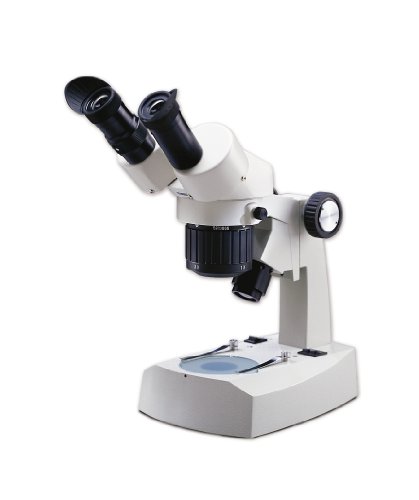The Frey Scientific variable magnification stereo microscope is used for inspection and dissection, creates three-dimensional images, has inclined binocular viewing heads with 10X widefield eyepieces, paired achromatic objectives, three-way dual-intensity tungsten incandescent illumination, and a durable cast aluminum body with enamel finish. Microscopes are widely used in education, lab research, biology, metallurgy, engineering, chemistry, manufacturing, and in the medical, forensic science, and veterinary industries.
This microscope features binocular viewing heads with a fixed 45-degree vertical inclination and 360-degree rotation capability. The 50 to 75mm diopter adjustment compensates for viewing abilities between each eye. Rubber shields add comfort and block out external light interference. The stereo optics have revolving turret objectives that are parfocalled, to stay in focus when objectives are rotated, and parcentered, so that the specimen remains in the center of view when the objectives are rotated. The microscope base has reversible and frosted stage plates that fit over the lower illuminator, and a blue filter to bring light closer to natural white and project a true image of the sample. Locked-on clips hold a specimen in place and a single mid-range focus control knob moves the objectives up and down for visual adjustment. Dual-intensity tungsten incandescent illumination shines light up from below through the specimen and from above the stage. The microscope uses 110V AC and comes with a US/North American plug. The microscope also comes with a clear vinyl dust cover and instructions.
Specifications
| Eyepieces | 10X widefield |
| Objective lenses | 10X and 20X, 10X and 30X, or 20X and 40X |
| Viewing configuration | Binocular 45-degree inclined head |
| Body type | Cast aluminum with enamel finish |
| Illumination | Three-way dual-intensity (10W and 15W) tungsten incandescent |
| Power supply | 110V AC |
| Overall dimensions | 34 x 15 x 21.5cm (H x W x D) |
| Stage type | Reversible |
| Stage dimensions | 80mm diameter |
| Weight | 10.3lb. |
| Warranty | Lifetime |
H is height, the vertical distance from the lowest to highest point; W is width, the horizontal distance from left to right; D is depth, the horizontal distance from front to back.
Microscopes are instruments used to enhance the resolution of an object or image. Types include compound, stereo, or digital. Compound microscopes use a compound optical system with an objective lens and an eyepiece. Stereo microscopes show object depth in a three-dimensional image. Digital microscopes are used to display an image on a monitor, rather than looking through a lens. Microscopes can have monocular (one), binocular (two), or trinocular (three) eyepieces, with varying viewing abilities. A trinocular eyepiece is used to output digital images or video to an internal or external device such as a camera or monitor. Magnification ability refers to the size of an image. Resolution, also known as resolvant power, refers to the clarity of the image. The interaction between field of view (FOV), numerical aperture (NA), and working distance (WD) determines resolution. Microscopes can control magnification through a fixed focus, or through a range of adjustments. They can also use LED, fluorescent, and mirror light sources to help control viewing capabilities. Microscopes are widely used in education, lab research, biology, metallurgy, engineering, chemistry, manufacturing, and in the medical, forensic science, and veterinary industries.
School Specialty provides instructional materials and supplies under dozens of brands, among them Think Math, Delta Education, Frey Scientific, Childcraft, and School Smart. The company, founded in 1959, is headquartered in Greenville, WI.
What’s in the Box?
- Variable magnification stereo microscope
- Rubber eyepiece shields (2)
- Vinyl dust cover
- Instructions

